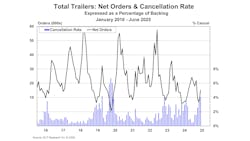U.S. trailer net orders more than doubled month-over-month in June, and were up about 150% from the year before, according to reports from market researchers. That’s the good news. The fine print, however, suggests that the surge follows particularly poor performance from May, and historically low orders in June 2024.
U.S. trailer net orders rose 113% to 13,827 units, FTR reported. Net orders were up 157% year-over-year (y/y) versus a June 2024 level that is one of the lowest since FTR began tracking the data in 2013. Only June 2023 and the lockdown months of April and May 2020 saw fewer trailer net orders than June of last year.
Despite the sharp improvement versus May’s net order volume, June still trailed the 16,134-unit monthly average for 2025 to date. The 96,803 year-to-date (YTD) net trailer orders were up 36% year-over-year.
Order cancellations fell to 17% of gross orders in June—a level that is much more typical than the close to 39% rate in May, the FTR report continues. Cumulative net orders for the 2025 ordering season (September 2024–June 2025) totaled 175,242 units, down 5% y/y and averaging 17,524 units per month.
During June, total U.S. trailer build increased 7% m/m but decreased 13% y/y to 18,071 units. 2025 YTD trailer build was down 26% y/y to 98,773 units, an average of 16,462 per month. With total trailer net orders significantly below build, backlogs decreased by 4,520 units (-4% m/m; -10% y/y) to 104,219 units. The larger decrease in backlogs compared to build lowered the backlog/build ratio to 5.8 months.
“Tariffs are increasing the materials cost of building trailers, especially with the doubling of the rate on imports of steel and aluminum to 50% in early June,” said Dan Moyer, FTR senior analyst, commercial vehicles. “Trailer manufacturers and their suppliers continue to face a difficult choice: either absorb the rising costs themselves or pass them on to fleets, which could significantly influence decisions around fleet expansion and maintenance. This financial pressure—along with lingering market uncertainty—appears to be leading many fleets to postpone new trailer purchases and instead consider refurbished units or alternative configurations.
“Ultimately, the market is becoming increasingly price sensitive. Trailer lifecycles are being extended, and demand is gradually shifting toward used equipment and non-traditional trailer options. These trends reflect a broader adaptation to the current economic and regulatory environment.”
'Pull forward'
Similarly, ACT Research reported net trailer order intake in June was nearly 15,400 units, up a “phenomenal” 133% from May and 144% higher than the subdued level of orders accepted last June, according to this month’s issue of ACT’s State of the Industry: U.S. Trailers report.
“This puts the Q2 tally at 30.9k and the year-to-date order total at 92,000 units, 24% higher than the 74,400 bookings for the first half of 2024,” said Jennifer McNealy, Director–CV Market Research & Publications at ACT Research. “Worth noting, June’s net order jump likely is, in part, a pull-forward of activity ahead of anticipated price increases. At this point, weaker intake continues to be expected through at least mid-Q3 when the 2026 orderbooks open.”
Reflecting “ongoing uncertainty” around market conditions, cancellations started to escalate in February, McNealy noted.
“Buttressed by some astronomical tank order cancellations, this month’s rate as a percentage of backlog rose to 4.2%,” she said. “Additionally, data continue to show high dry van cancellations.”

